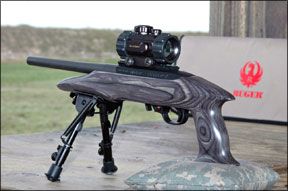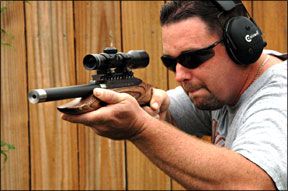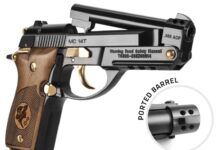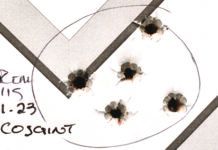In this evaluation we will test two guns that are difficult to categorize. They are listed as being pistols but some people call them hand rifles. The guns in question are the $380 Ruger Charger CHR22-10, and the $695 Magnum Research Picuda MLP22BN. Each is a 22LR semiautomatic with 10-inch barrel, and with an action based on Ruger’s aluminum 10/22 rifle action. Both guns plant the action inside a laminate stock with an extended grip that is flared at the butt to stabilize contact with the ground or shooting bench. Neither gun arrived with sights, but they were fitted with a Weaver scope mount. Each gun fed from a 10–round rotary magazine made by Ruger. The Magnum Research Picuda was perhaps more radical in appearance due to a graphite barrel and extra machine work atop the receiver. Our tests will compare the performance and reliability of each gun, and we’ll try to determine if one manufacturer or the other had the better recipe for this hybrid weapon.

In formulating this test, we encountered a couple of drawbacks. First, we learned that the Picuda was currently out of production. But using the search engine on the manufacturer’s website still brings up six different models. Happily, we were able to find that wholesalers such as Davidson’s galleryofguns.com still had plenty of inventory, so we felt justified in going forward. Besides, with the renewed interest in less expensive rimfire ammunition, it might make a comeback. Or, at the very least, the PiCuda could provide tips on building upon the 10/22 action, which probably trails only the 1911 and the AR platforms in available parts. (One supplier, brownells.com, lists more than 158 entries for the Ruger 10/22 action). Finally, we had to modify our specifications chart to include characteristics of both rifle and pistol. We specified Action instead of Slide, substituted Receiver for Frame, and added Stock just below the word Grip, to better describe each gun’s profile and construction.
To test each gun, we fired five-shot groups from a sandbag rest at a public range. This led to interruptions by onlookers who agreed with us that just looking at these fancy guns was a treat. We sighted in quickly from the 50-yard benches and ultimately decided to test from this distance as well. We considered collecting data from the 100-yard benches, but feared that absent of perfect shooting conditions (shifting crosswinds were trying to bring in rain), results might tell us more about the shooter than it would about the guns. For optics we chose a HiLux ES1X30 Tactical scope by Leatherwood. This scope featured a 3-MOA red dot inside a short 30mm tube with 1X magnification. We could have mounted a long-relief pistol scope or even a higher-powered rifle scope. Given the chambering there was no danger of recoil pushing the scope back into our faces, but we decided against using optics with magnification because the 1X sight picture was quicker to read and easier to stabilize. This was a consideration because neither gun was designed to be shouldered. In addition, only a very strong person would be able to shoot these guns offhand in the manner of a true pistol, with both hands surrounding the grip.

A variety of ammunition was run through each gun and the result was the same. Each gun had one single malfunction over several hundred rounds, and both times the culprit was soft-shooting target ammunition not driving the bolt to fully eject the spent case. Since these guns were probably meant for hunting squirrels, rabbits, or prairie dogs, or knocking down steel silhouettes, we’d probably load them with the hottest rounds we could find, anyway. That’s not to say we limited our tests to shooting exotic ammunition. Shots of record were fired using typical “big box” fare. Test rounds included Remington’s Golden Bullet, a 36-grain brass-plated hollowpoint, and two choices of CCI Mini-Mag. They were the 40-grain copper-plated round nose and the 36-grain hollowpoint rounds. The devil is always in the details, so, let’s see how these two similar guns performed.
Ruger Charger CHR22-10 22LR, $380
Our Ruger Charger was shipped in a handsome tan zippered carrying case with red logo. Alongside the Charger we found a high-quality Harris-style 6- to 9-inch bipod to be attached via the Charger’s sling stud. We doubt Ruger had sling carry in mind, but it did offer abundant solutions for additional support in the field. The supplied short bipod favored the prone position. For shooting from the seated position we applied a long-legged Versa Pod model 3 ($81 from versapod.com). We added a cuff-style rifle sling reaching from the bicep of the support arm to the swivel stud on the Versa Pod connector and from that point on we felt in total command of aiming our Charger.
The Charger design is striking enough in profile, but the black laminate stock offered additional appeal. The receiver was coated with a matching finish that appeared to be an epoxy base. It was matte in texture. Barrel twist was 1:16 inch and showed a Sporter profile, tapering from the receiver to the mildly recessed crown at the muzzle. The action utilized a crossbolt safety, and the standard 10/22 bolt handle was in place.
One upgrade to the action was an extended magazine release. Normally removing a 10/22 magazine requires sort of a pinching movement. The thumb reaches in and depresses the hinged plate to the rear of the magazine while the index finger plucks the front of the magazine from the well. Sometimes pushing forward on the Charger’s extended release let the magazine drop, and other times one needed to tickle the front of the magazine to coax it free. We found that pulling back the slide, not necessarily holding it back, but releasing the bolt from its adhesion to the chamber for a moment, helped free the magazine.
Both guns arrived with a single 10-round rotary magazine. The boxy outer shape of the rotary magazine may make it clumsier to handle than a vertical stack magazine, but many feel that the rotary design is more reliable. That is because as the vertical magazine empties, the amount of energy available to push the next round upward can diminish. The rotary magazines on our test guns worked flawlessly.
Initially, we had difficulty locking back and releasing the bolt. The bolt-release lever located just forward of the trigger guard was, according to the manual, meant to be pressed back to lock the bolt open and pressed upward to release the bolt. We found that the release needed to be moved upward and with a bit of a counter clockwise arc as well. Key to locking the bolt open or letting it forward is the ability to first move the bolt fully to the rear. The left-handed shooter may have an advantage here because the right-handed shooter must abandon his grip to operate the bolt.
Until we learned the following regimen we were blaming the bolt release/lock for being balky. The left hand gripped the forward portion of the stock. We braced the rear of the gun against the body. Pulling the bolt back with the right hand, the right-hand thumb was then braced behind the rear scope ring. Holding the gun between the bolt handle and the rear scope ring, the left hand was free to set or release the bolt.
Once we learned that a loaded magazine could be inserted with or without the bolt locked back, we simplified handling by charging the guns beginning with the bolt closed. Another reason we chose this method was that neither gun was designed to lock open when the magazine was empty. But we often ended up dry-firing when the magazine was empty. We’re not sure at what point pulling the trigger on an empty chamber will damage the firing mechanism, but we think this could be a problem at some point.
Firing the Charger from the bench with the bipod in place gave us a solid hold. But on recoil the gun bounced around. It did not necessarily affect point of impact, but we had to reset the gun after each shot. Firing prone with the bipod in contact with soft ground negated this problem. We found that using a bipod in the field was a real advantage, but for bench work we preferred supporting each gun with simple sand-filled pillow-style bags. Our initial firing session was interrupted when we suddenly found our point of impact changing. The problem was quickly diagnosed as a loose scope mount. The mount itself was a lightweight alloy that was also treated to the same matte finish as the receiver. This coating was rubbed off easily by the crossbolts of our scope rings. But we tightened the mount and suffered no further problems.
From the bench we found it easy to get into a groove of finding our point of aim and squeezing the trigger. Trigger pull weight was about 4.5 pounds, and there were some hints of grit from time to time, but we liked the way we could break a shot and reset. The red dot let us find the target quickly, and we could imagine multiple targets, be they small game or tin cans, becoming great sport.
In terms of accuracy, the Charger liked the CCI Mini Mag hollowpoints best. We managed a best single group measuring about 0.8 inch across. Average groups measured about 1.2 inches overall. The Ruger Charger lent itself to firing from a number of positions, making it a lot of fun to shoot.
Our Team Said: This is a fun, inexpensive firearm that can be easily upgraded. It can be shot prone, seated, standing, or from a bench. The availability of a lone sling stud allowed us to add any style bipod and/or sling and fire from a number of suitable positions. Finding the one we liked best doubled our fun. The Charger can be fit with any manner of scope.
Magnum Research PiCuda 22LR Graphite Pistol MLP22BN, $695
Typing PiCuda, the acronym for Pistol Barracuda, into the magnumresearch.com website search window revealed six different models. Three were chambered for 17 Mach 2 and three for 22LR. Both calibers were made with laminate stocks in colors Barracuda, Nutmeg, and Forest Camo. What may have led to the stall in manufacturing the PiCudas, which took place about one year ago, were ammunition difficulties for the Mach 2 editions. Admirably, Magnum Research got out in front of the problem by offering an exchange of Mach 2 PiCudas for 22LR models. Regarding the question of warranty service for a discontinued model, we would read this as a very positive sign.
Our PiCuda was fit with the Nutmeg-colored stock. The grip was the same basic profile as the one found on the Charger but with a slimmer profile. Perhaps the most pressing question is, why does the PiCuda cost about $300 more?
Well, to start, the scope mount is not going to come loose because it was machined as one piece with the receiver. The mount was elevated about one-half inch above the action by some pretty fancy machining. We really liked it. It was handsome, precise and shared the durable French grey anodized finish with the receiver. There was no sling stud onto which we could attach a bipod, but there was an oversized bolt handle. Bolt action was enhanced by way of a “match bolt kit.” The result was that pulling back the bolt was much easier than on the Charger. We didn’t have to brace the gun against our body to pull it back, and the bolt lock/release had been refined. It was a pleasure to use. A match trigger was installed that presented the same amount of resistance found on our stock Charger, but the movement was more refined, smoother, without grit or unnecessary takeup.
The 10-inch barrel consisted of a steel sleeve surrounded by graphite. The reason for this design was to provide a rigid barrel that dissipated heat quickly. Keeping a barrel cool is one way to avoid variation in point of impact over the course of a long shooting session.
One easy modification we would recommend would be to install a sling stud. This would allow for attaching a bipod or a sling for support. Another option for shooting the PiCuda offhand would be to use a Steady Strap. The Steady Strap, about $21 from dura-cover.com, is a sling-like device designed to offer a tension-based platform. One end is looped around the shooter’s neck and the other over the shooter’s thumb, on either the strong hand or the support hand. To fire the PiCuda standing, we chose to stabilize the weapon utilizing a push-pull hold between the grip and the support hand, which was placed on the forend of the stock. But we much preferred shooting from support. Stoney Point’s Steady Stix II ($40-$60 from cabelas.com) would be one solution. Steady Stix II is a type of bipod that does not require attachment via a sling stud and can be used from both the seated and standing position.
At the range the PiCuda displayed a much different preference in terms of ammunition. Wherein the Charger preferred our two varieties of CCI Min Mag ammunition, the PiCuda would rather munch on the Remington Golden Bullets in the 525-round value pack. The Mini Mags HPs were printing groups ranging in size from 1.3 inches to 1.5 inches across, and the round-nosed CCIs were pretty consistent, landing 1.2-inch groups. Firing the Remington ammunition we managed to shoot groups of 0.8, 0.9, 1.0, and 1.1 inches before landing a 1.5-inch group to spoil the fun. That the PiCuda only excelled firing one of our test rounds should not be discounted. Given our limited choice of test ammunition in a crowded field, we read this as direction towards other rounds that may provide greater accuracy.
Our Team Said: The extra cost when compared to the Charger was justified by the addition of high-grade parts, a superior finish, and the one-piece machined receiver with integrated scope mount. In fact, the PiCuda features several of the many hop-up parts that can be applied to a 10/22 action. In addition, it was obvious that many stock pieces were refined and hand-fit for improved operation. But without a significant leap in accuracy, the additional cost might cause some to grade it down a notch.




























Don’t know if this is too late or not but I have both (Charger has a 10″ Kidd barrel) , and they’re GREAT for long-range prairie dogs with big optics and tree reticles!!